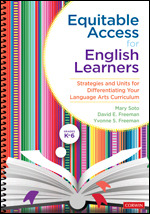Equitable Access for English Learners, Grades K-6
Strategies and Units for Differentiating Your Language Arts Curriculum
- Mary Soto - California State University, East Bay, USA
- David E. Freeman - University of Texas Rio Grande Valley, USA, University of Texas at Brownsville
- Yvonne S. Freeman - University of Texas Rio Grande Valley, USA, University of Texas at Brownsville
Bilingual/EAL Learners | Literacy (Primary/Elementary) | Primary Education (General)
Plain and simple: until our English learners have equitable access to the curriculum, they’ll continue to struggle with subject area content. And if you’re relying on add-on’s to fit in from your language arts basal or a supplementary program, Mary Soto, David Freeman, and Yvonne Freeman are here to equip you with much more effective, efficient, and engaging strategies for helping your English learners read and write at grade level.
One assurance right from the start: Mary, David, and Yvonne are not suggesting you reinvent your curriculum. Instead, Equitable Access for English Learners, Grades K-6, focuses on how to fortify foundational practices already in place. First, you’ll learn more about the Equitable Access Approach, then it’s time to dive into the book’s four units of study. Drawing on each unit’s many strategies, you’ll discover how to apply them to any unit in your own language arts curriculum and start differentiating:
- How to draft and implement language objectives to help English learners meet academic content standards
- How to make instructional input comprehensible, including translanguaging strategies that draw on your students’ first languages when you don’t know how to speak them
- How to utilize the characteristics of text to support readers, along with a rubric for determining a text’s cultural relevance
- How to build students’ academic content knowledge and develop academic language proficiency
Each unit addresses a commonly taught topic in today’s language arts programs and comes with ready-to-go review and preview activities, key strategies, grade-level adaptations, reflection exercises, and printable online resources. Taken as a whole, they constitute an all-new approach for providing that equitable and excellent access our English learners so rightfully deserve.
“When you adopt our Equitable Access Approach, your students will not only thrive, they’ll also find your language arts curriculum much more meaningful and engaging.”
—Mary Soto, David E. Freeman, and Yvonne S. Freeman
